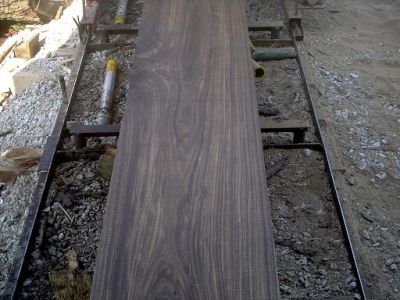Dealing with Heavy Pitch
Antique heart pine and other pitch-heavy woods can clog blades up quickly. Here's some good advice on keeping blades clean. May 11, 2005
Question
I had a job sawing 1" flooring from heart pine cants (4x4 to 6x12) which came from 100+ year old trees and had been barn-dried for up to 50 years. Some of these cants were completely lightwood/fatwood. The band oiler on my Cook's MP-32 consists of 2 kerosene drips onto felt pads which wipe the top of the band both before and after the cut. The underside of the band accumulated so much pitch that the band began to rise in the cut near the end of the cant and actually exit, not at the end of the cant, but through the top of the board being cut! This is obviously an extreme situation, but I would like comments on others' experience in sawing such extremely pitched pine.
Forum Responses
(Sawing and Drying Forum)
From contributor B:
I usually use diesel fuel for my drip lube, but if I'm resawing heart pine or sawing tamarack, I switch to water and let it flow heavy. It seems to deal with the pitch better, in my opinion.
From contributor C:
Try lacquer thinner as long as sparks/flames are not a risk. (It is pretty volatile). I know what you mean about the pitch buildup... remilling antique heart pine is my business, but I use a circular saw and clean the blade with spray automotive carburetor cleaner and a brass brush. Spray silicone works well, too. I don't know if it's the silicone or the carrier solvent that does the trick.
From contributor D:
We have attached a platers wire brush (looks like a toothbrush) to the guide frame. It wipes the sawdust off the blade before it gets mashed against the wheel. Precise blade set helps a lot. If the dust accumulates in the cut, the blade gets warm enough for the pitch to stick, and the problem worsens steadily. We also use a lot of water to try to flush the dust out and keep the blade cool. Won't use diesel because we used trailer wheels and tires to build our mill. If I catch the buildup in time, I scrape the blade, while running (from the backside) with the corner of a putty knife. First sign of dust sticking, you gotta do something, quick.
From Gene Wengert, forum technical advisor:
Although some pitch sticking to a blade is hard to avoid, heat makes the problem much worse. So avoid slow cutting when you will get a lot of heat due to rubbing, use water to cool the blade, use very sharp teeth (dull means more heat), and use enough set to assure that the blade has plenty of room. Solvents do dissolve the pitch but are very dangerous, especially if they drip onto the sawdust. A little self heating in the sawdust and all of a sudden... poof. Steam cleaning will work.
From contributor L:
Prior to sawing SYP in my woodshop, I will coat a clean blade with PAM cooking spray. Reduces the pitch buildup in the gullets and teeth.
From contributor K:
Try using citrus solvent. I buy it in the concentrated form and it works great. I'll put about a pint or so in 5 gallons of water and let it flow liberally. I mill a lot of white pine and occasionally heart pine timbers and rarely get buildup on the blade, and if I do I'll just turn the flow up a bit and it clears up. It's also good in a spray bottle for cleaning rails and other surfaces, cleaning and lubricating saw chains as you sharpen them. It's not flammable and it has a nice smell.
From contributor T:
Please do not use silicone products in any milling of lumber. That slippery (slimy) slip-a** flat molecule is next to impossible to remove and is a vile contaminant, causing untold misery for finishers and painters. SC Johnson will hate me, but I hate Pledge!
From contributor E:
I sawed 1000 feet of white pine 2 months ago, and I found that just using a liberal water drip was sufficient. Lots of water, that's all. All the pitch on my band accumulated on the inside of the band (the part that touches the band wheel). After each cut, I'd just let the saw ride a few seconds until I can hear it quiet down, and then I know it's riding on the water, not the pitch anymore. That few seconds is all it takes to remove the pitch. I was using Monkforsager blades, if that makes a difference. I've heard (but haven't tried) that Pine Sol mixed with water will cut the pitch right out. Not sure of the ratio, or whether it really works.
From contributor N:
We resaw antique longleaf every day, exclusively. Pine-Sol is the cheapest route with water. Use about 1/2 a bottle in 2 gallons and let it drip on the top and inner bottom. May not be the best choice, but is definitely the cheapest. A little Dawn doesn't hurt, either. Don't use lacquer thinner!
